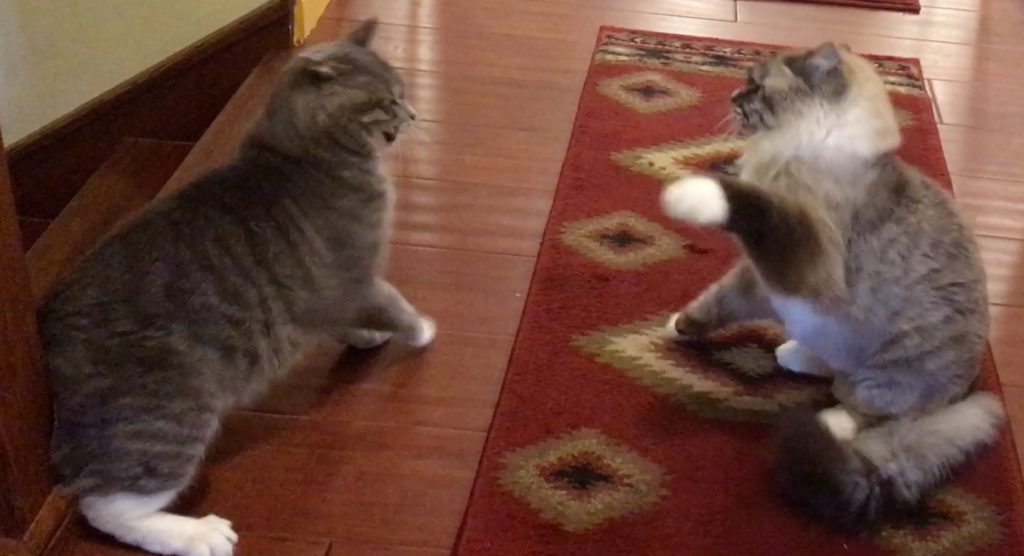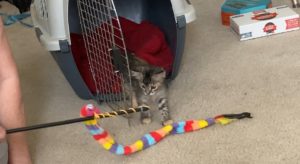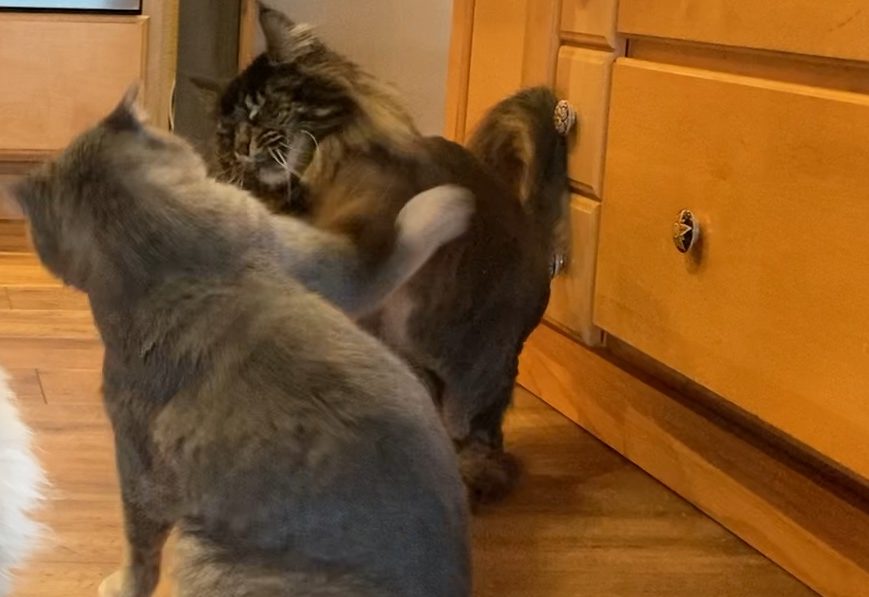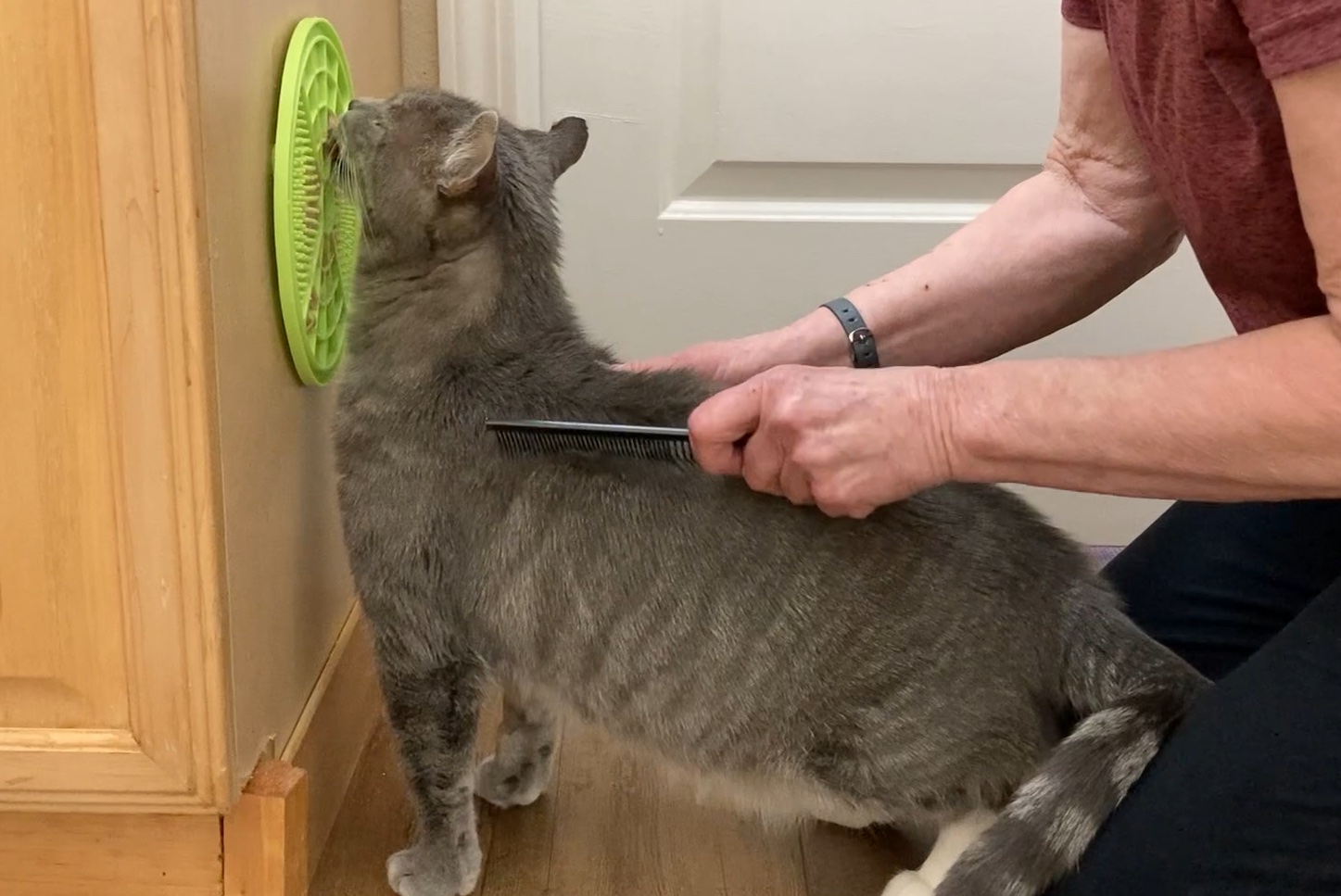 You are sitting by the window, engrossed in your latest murder mystery. You don’t notice that neighborhood tabby outside your window but your cat does and goes into full battle mode, hissing and striking at the window. You look up and jump, as your cat turns and strikes out at you. She looks like a miniature saber tooth tiger! Alarmed, you throw your glass of water at her as you beat a hasty retreat.
You are sitting by the window, engrossed in your latest murder mystery. You don’t notice that neighborhood tabby outside your window but your cat does and goes into full battle mode, hissing and striking at the window. You look up and jump, as your cat turns and strikes out at you. She looks like a miniature saber tooth tiger! Alarmed, you throw your glass of water at her as you beat a hasty retreat.
This is an example of what we call redirected aggression. Something happens that frustrates or frightens a cat, and the cat strikes out at whomever is closest. The cat cannot strike out at the cause of the arousal – it may be out of reach or too risky to confront. In this case, the tabby cat is out of reach but you are not!
People can find themselves in a similar situation. Say you get criticism from your supervisor. You can’t retaliate – it could effect your work evaluation. So, instead, you “take out” your frustration and anger on the assistant helping you, directing some snarky comments at her.
Avoiding Redirected Aggression in your cat
As Benjamin Franklin observed, “An ounce of prevention is worth a pound of cure.” Be aware of situations that could trigger redirected aggression in your cat or any cat. Redirected aggression can damage the cat-owner bond if either the owner or cat is hurt. Redirected aggression can wreak havoc on the fragile harmony of a multi-cat household.
things that can Trigger Redirected Aggression in your cat
- presence of another cat
- high-pitched or loud noises
- visitors in the house
- a dog
- an unusual odor
- being outdoors unexpectedly
Your cat may feel he must defend his territory against strange cats, visitors to the house and dogs. He may scratch or bite when you intervene to move him to a safe place.
Strange odors, say smoke from a wildfire burning nearby, and loud noises can instill fear in your cat and he starts fighting with his housemate.
Being outdoors unexpectedly can be terrifying to the indoor-only cat and she may vent her fear on her would-be rescuer using her teeth and claws.
These are all situations where a cat may strike out and attack an “innocent” bystander because the cat is aroused or frightened.
Watch your cat’s body language for aggression: hair standing on end, growling, hissing? Staring at other cats, dogs, people? Is she blocking another cat from areas in the house? Stalking another cat?
Removing the Triggers for Redirected Aggression in Your Cat
Outdoor cats:
- Discourage them coming into the yard using a motion activated sprinkler.
- If you have a fence around your yard, cat proof it .
- Install privacy film on windows where your cat may see outdoor cats.
- Place scratching posts by doors and windows and allow your cat to mark his territory by scratching
Loud noises: If a loud noise scares your cat, let her hide and calm down before handling her. Once calm, try to entice her with a tasty snack or a wand toy. Wait for her to approach you.
Visitors: Advise visitors to leave the cat alone unless she comes over to greet them.
Dogs: Keep dogs separate from the cats using a baby gate or other barrier until you introduce them, one cat at a time.
Odors: You may need to separate cats and put them in quiet rooms until the odor dissipates or the cats acclimate to it. (In the case of wildfires, you may wish to have the carriers out and ready to go. Having the cats in smaller rooms will make it easier to kennel them up if you need to evacuate).
Being outdoors unexpectedly:
- Your indoor cat escapes and you find her hiding under the steps. Avoid trying to pull her out.
- Instead, arm yourself with patience and tasty food.
- Get her cat carrier and cover it with a towel (making it appear dark and safe). It may take a little time but there is a good chance she will choose the safety of the carrier over the “great outdoors”.
If you have trained your cat to come when called, call her periodically – give her time to get over her fright and let her training kick in. And having her carrier with you can help you get her back indoors.
Redirected aggression in your cat is a consequence of an emotional state. He may be ready to fight, frustrated or fearful and he vents these emotions on whomever is close because he cannot reach what’s triggering the emotion or he cannot flee the situation.
Join The Feline Purrspective next week for “Redirected Aggression in Your Cat – When It Becomes a Problem”.

 Kitten kindergarten programs are great ways to continue to expose kittens to new experiences and accustom them to humans. But what if you can’t find one of these programs near you? Consider introducing your kitten to your friends and family in your own home.
Kitten kindergarten programs are great ways to continue to expose kittens to new experiences and accustom them to humans. But what if you can’t find one of these programs near you? Consider introducing your kitten to your friends and family in your own home. Lure your kitten out with treats or a toy. Allow her to approach people on her own – reward with a treat or play. Guests can take turns luring the kitten with toys, cuddling the kitten (if she accepts this) and offering snacks!
Lure your kitten out with treats or a toy. Allow her to approach people on her own – reward with a treat or play. Guests can take turns luring the kitten with toys, cuddling the kitten (if she accepts this) and offering snacks!






